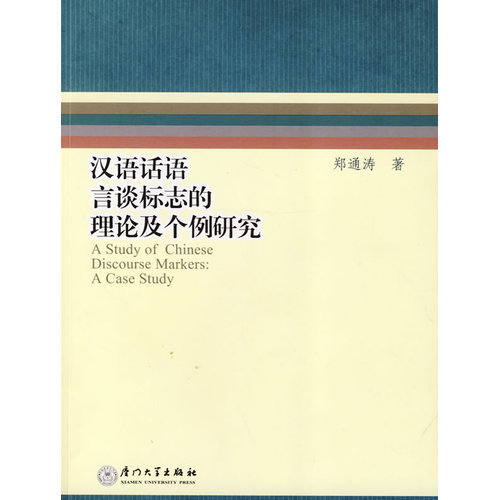《漢語話語言談標誌的理論及個例研究》是2009年東力出版社出版的圖書,作者是鄭通濤。
基本介紹
- 書名:漢語話語言談標誌的理論及個例研究
- 作者:鄭通濤
- ISBN:9787561533130
- 頁數:268
- 定價:35.00元
- 出版社:第1版 (2009年7月1日)
- 出版時間:2009-7
- 裝幀:平裝
- 開本:16
內容簡介,編輯推薦,目錄,
內容簡介
本書研究的是在話語分析中甚至是傳統語言研究中經常被忽略的一類成分,即言談標誌。一部分言談標誌在傳統的結構主義語法中被稱為語氣詞。但是並不是所有的言談標誌是語氣詞。比如說“你知道嗎”、“對不對”是漢語話語分析中的言談標誌,但它們卻不是傳統意義上的語氣詞。
本書共分為八章。分別為:第一章,西方話語分析以及漢語話語分析的文獻及評析;第二章,漢語中言談標誌定義以及言談標誌的確定;第三章,漢語言談標誌的語音特徵及其分布;第四章,漢語言談標誌與認知系統的關係;第五章,漢語言談標誌在言語交流中的位置及作用;第六章,漢語言談標誌在話輪、語段、篇章以及交際互動中的作用;第七章,漢語言談標誌與文化人群的關係;第八章,結論,漢語言談標誌的理論模式也同時在本章中歸納出來。本書視角新穎、論述充分,大量運用了國外多學科的研究成果,相信對讀者會有一定的啟發。
編輯推薦
漢語的話語分析研究使得漢語研究從傳統的詞及句子分析走向段落及篇章分析。從傳統的句子成分分析法或古典的結構主義語法分析中走出來。對語言使用者的言語能力進行了系統的分析與歸納。傳統的漢語語法深受英語影響,實際上是英語語法的翻版。全盤照搬英語語法來研究漢語在很大程度上忽視了漢語本身的特點。學科的劃分是人為的,可是科學現象並不是依人們所劃分的學科而存在的,因此,用多學科研究方法來研究漢語是勢在必然。本書用話語分析方法對漢語的言談標誌進行了比較詳細的分析,尤其對一個漢語標誌從多學科角度進行了分析。研究時採用了了語用學、社會學、心理學、人類學、文化學、資訊理論以及控制論等學科的研究方法,將語言交際過程與信息系統中的信息交流過程相提並論,將語言研究置身於一個較為開闊的視野內。本書可為從事語言以及對外漢語教學的同人和愛好者提供參考,讓他們能夠從言語交際的角度觀察言語能力是以什麼樣的方式表現出來。作者認為,本書能從另一角度為語言教材的編寫、教學方法的更新以及教師的培養提供一種參照體系。
目錄
General Introduction
Transcription and Glossing Conventions
Abstract
中文摘要
Chapter 1 Introduction
1.1 A Short History of Discourse Analysis
1.2 A Short History of Text Analysis in China
1.3 The Studies of the Discourse Markers (DMs)
1.3.1 What areDMs
1.3.2 Scholars' Views of DMs
1.4 Single Discourse Marker Studies
1.5 Chinese DMs Studies
1.6 Conclusion
Chapter 2 Discourse Markers in Amoy Chinese
2.1 Amoy Chinese
2.I.I DMs in the Turn-initial Position
2.I.2 DMs in the Turn-final Position
2.2 Some Intonation Features of DMs in Amoy Chinese
2.3 Influence of Topic on the Occurrence of h
2.3.1 Discourse Topic
2.3.2 Discourse Topic and the Use of DMs
2.3.3 Classification of Topic and hS' s Correlation
2.4 h and Social Variables
2.4.1 Sensitive to Conversational Contexts
2.4.2 Sensitive to Degree of Intimacy
2.4.3 Co-occurrence with Other Intimacy Markers
2.5 Discourse Structures and the Occurrence of h
2.5.1 A Classification of Discourse Structures
2.5.2 h Connects Discourse Structures to the Topic
2.6 Speech Acts and the Occurrence of h
2.7 Speaker Subjective Certainty and the Occurrence of h
2.8 Dependent Nature of h
2.9 Relevant Knowledge and the Occurrence of h
2.10 The Relationship between h, Entropy and Redundancy
2.10.1 Entropy and Redundancy
2.10.2 DMs as Stabilizing Devices
2.10.3 h's Use in Stabilizing Conversation
2.11 Conclusion
Chapter 3 Prosodic Features Associated with h
3.1 Relationship between Prosodic Features and Affective Meaning
3.2 Basic Prosodic Features of DMs in Chinese
3.3 The Difference between Tonic Patterns of DMs and Lexical Tones
3.3.1 Different Distributions and Different Functions
3.3.2 Inconsistent Relations DMs of Intonation among the Dialects
3.3.3 The Inconsistent Correspondence in One Language
3.3.4 The Features of Tonic Patterns of Chinese Auxiliary Words
3.3.5 A Consistent Regular Tonic Patterns of DMs in Chinese Languages
3.3.6 The Foregrounding Function of DMs
3.3.7 Semantic Variation of DMs' Tonic Patterns
3.3.8 The Hierarchical System of Tonic Patterns of DMs
3.4 Tonic Patterns of DMs Associated with Speech Acts
3.5 Varied Tonic Patterns of DM h
3.5.1 Falling Intonation of h
3.5.2 Rising Intonation of b5
3.5.3 High Level Intonation of h
3.5.4 Long and Short Length Intonation of
3.6 Phonological Comparison between Initial and Final h
3.6.1 Two Different Distributions and Their Implications
3.6.2 A Distribution Hypothesis of DMs
3.7 The Pause after DM h
3.7.1 The Length of Pause in Two Positions
3.7.2 "Intensified Orientation" of the Pause
3.8 h and Previous Emphasized Syllables
……
Chapter 4 h and Information Management
Chapter 5 h in the Turn-taking System
Chapter 6 h and Coherence
Chapter 7 h and Interpersonl Relationships Reflecting Amoy Chinese Culture
Chapter 8 Conclusion
Bibliography

